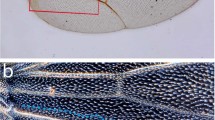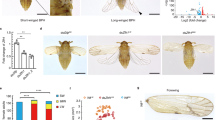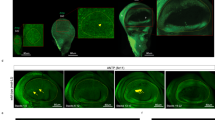Abstract
Here we reply to the “Refutation” of Lawrence, Casal, de Cellis, and Morata, who critique our paper presenting evidence for an organizer and compartment boundary subdividing the widely recognized posterior wing compartment of butterflies and moths (Lepidoptera) and Drosophila, that we called the F-P boundary. Lawrence et al. present no data from the Lepidoptera and while the data that they present from Drosophila melanogaster mitotic clones are intriguing and may be informative with respect to the timing of the activity of the A-P and F-P organizers, considerable ambiguity remains regarding how their data should be interpreted with respect to the proposed wing compartment boundaries. Thus, contrary to their claims, Lawrence et al. have failed to falsify the F-P boundary hypothesis. Additional studies employing mitotic clones labeled with easily detectable markers that do not affect cytoskeletal organization or rates of cell division such as GFP and RFP clones produced by G-Trace or Twin Spot Generator (TSG) may further clarify the number of compartment boundaries in Drosophila wings. At the same time, because Drosophila wings are diminutive and highly modified compared to other insects, we also urge great caution in making generalizations about insect wing development based exclusively on studies in Drosophila.
Replying to: Lawrence, P.A., Casal, J., de Celis, J., Morata, G. A refutation to ‘A new A-P compartment boundary and organizer in holometabolous insect wings’. Sci. Rep. 9 (2019), https://doi.org/10.1038/s41598-019-42668-y.
Similar content being viewed by others
Introduction
Here we make a brief response to Lawrence et al.1 and their “Refutation” of our recent paper in which we presented evidence for a previously unreported pattern organizer and developmental far-posterior (F-P) compartment boundary in wings of butterflies and moths (Lepidoptera)2. We also used FLP-FRT induced mitotic clones to identify a possible homologous compartment boundary in Drosophila2. The bulk of our paper2, part of a series exploring the evolution and development of wing patterns in Vanessa butterflies3,4, focuses on data from butterflies and moths including a statistical analysis of butterfly eyespot phenotypes, butterfly wing immunohistochemistry, and a review of clonal boundaries on the wings of lepidopteran mosaic gynandromorphs and mosaic homeotic mutants.
Lawrence et al.1 make only one substantive comment regarding our lepidopteran experiments: that the independent contrast analysis of Vanessa butterfly eyespot structure does not show a similar effect of the A-P compartment boundary to that shown by the F-P compartment boundary. They assume that the organizers associated the A-P and F-P boundaries should have similar effects on colour pattern development. However, there are many examples of serially homologous developmental features (e.g. legs, mouthpart, and antennal imaginal discs in arthropods5) that are organized and patterned differently during development. There is no reason to assume a priori that both boundary organizers should have the same effects on colour pattern, especially if they are active at different stages of wing development.
Thus, all of the findings that we presented from the Lepidoptera remain unchallenged and so rather than a “Refutation”, Lawrence et al.1 is largely a critique of a single experiment: our analysis of Drosophila mitotic wing clones marked with yellow mutations2 and created using the FLP/FRT technique6. On the one hand, they describe how they created “genetically marked clones rather as Abbasi and Marcus have done”1, while on the other hand they find our results unconvincing because our clones differ in shape from clones marked with multiple wing hairs that they have created by mitotic crossover using X-rays, in some cases in a Minute background. Given that Minute mutants have profound effects on cell growth7, clones that involve these factors (either in the clone itself or in the surrounding tissue) will differ in size from clones where the rate of cell division has not been manipulated8. Similarly, the multiple wing hairs mutant phenotype is a consequence of cytoskeletal reorganization9 that can disrupt epidermal cell polarity10. Further, X-ray exposure can have a dramatic effect on the proliferation dynamics of cells in the imaginal wing disc11, by causing both cell death and compensatory proliferation of surviving cells12 with profound effects on wing clone characteristics11. Thus, given the extent to which Lawrence et al.1 manipulated fundamental cellular traits to produce their clones, it should be no surprise that our reported clone shapes and sizes are different2.
Lawrence et al.1 also question our use of yellow as a lineage marker in Drosophila. The yellow gene product is a secreted peptide that appears to be an essential cofactor in the L-dopachrome tautomerase enzyme complex13 which converts the soluble substrate dopachrome into insoluble 5,6-dihydroxyindole (DHI)14, a melanin precursor15. In the extracellular matrix yellow protein is embedded in the developing cuticle and may function in part to anchor pigment molecules to the cuticle16, so for the most part the yellow gene product functions cell-autonomously in mosaics17,18. For this reason, yellow mutants have been used extensively to mark clones for genetic mosaic analysis6,10,19,20. Drosophila yellow mutations have discernable wing phenotypes in both bristles and trichomes17 and these phenotypes have been used successfully by other workers to label wing clones in D. melanogaster21,22 and in D. hydei (using mutants in the homologous D. hydei yellow gene)23. We first encountered yellow wing clones when P-element mobilization-induced mitotic recombinants marked with y1 appeared incidentally in the course of a mapping experiment involving over 90,000 flies24. We are genuinely puzzled by the objections of our critics1 to the use of yellow to mark mitotic clones, when they have endorsed and popularized its use as a cell-autonomous marker in other tissues and contexts25,26,27.
Regarding the data presented by Lawrence et al.1, the patches of marked cells that cross the F-P boundary could be explained by contiguity of 2 or more adjacent mitotic clones on either side of the boundary such that they resemble a single larger “clone”. While they claim that the presence of 2 or more fused clones is improbable, it has been shown that the 1000 R dose of radiation used by Lawrence et al.1 will produce 2 or more clones in ~65% of all Drosophila wings with induced mitotic clones11. Further, in a Minute- background each individual Minute + clone becomes proportionately larger7,8, while the overall size the wing remains the same28, increasing the likelihood that 2 nearby clones will fuse and appear as a single larger, uniformly marked “clone” that appears to cross a developmental compartment boundary.
The fact that the marked “clones” of Lawrence et al.1 appear to respect the A-P boundary, but apparently violate the F-P boundary suggests to us that there may be a difference in the timing of the creation of these boundaries relative to the timing of mitotic clone creation in their experiments, possibly with the A-P boundary being established earlier in development. Differences in timing may also explain the results of the twin spot experiments in Drosophila (where the number of clones can be determined precisely) summarized by Table 1 of Lawrence et al.1 If X-ray induced recombination creates mitotic clones before a developmental compartment is specified, cells marked by one of the two mutations used to mark the twin clones can appear on both sides of the compartment boundary. This is similar to observations of bilateral and some mosaic lepidopteran gynandromorphs where cells in both anterior and posterior wing compartments are included within the same clone and thus marked with the same phenotype29,30.
Lawrence et al.1 have suggested that the cellular behavior that we link to a possible F-P boundary in Drosophila wings may be due to the presence of a documented secondary organizer apparently without a corresponding compartment boundary in the posterior compartment of the Drosophila wing and haltere imaginal discs associated with Dpp expression during the 3rd larval instar31. Whether this additional Dpp-dependent organizer actually does coincide with an F-P compartment boundary as we have proposed in Drosophila2, or alternatively whether it exists in both Drosophila and other insects independent of any compartment boundary31, or finally whether the apparent compartment boundary-independent state in Drosophila represents an evolutionary derivative of an boundary-associated organizer found in other insects with less derived wing structure and development as proposed by Lawrence et al.1 all remain to be determined. To date, transcriptomic profiling of the homologous posterior region of butterfly wing imaginal discs has not recovered dpp transcripts32, so even if Dpp is the relevant patterning organizer in Drosophila, this may not be a general mechanism shared by all insects. In our published model based on observed patterns of A-P eyespot individuation in butterflies2, we also suggested that the A-P organizing signal (Dpp) and the F-P organizing signal are likely to be different gene products with independent patterning effects on wing tissue.
In conclusion, we welcome all critical scrutiny of our work and its interpretation, and we are pleased that Lawrence et al.1 join us in calling for additional research on these very interesting aspects of insect wing development. However, Lawrence et al.1 have not convincingly falsified the Far-Posterior compartment and organizer hypothesis in Drosophila melanogaster, nor have they presented any relevant data to address that hypothesis in butterflies or other insects. The current disagreement concerning Drosophila wing compartment organization might be resolved by studies employing mitotic clones labeled with easily detectable markers that do not affect cytoskeletal organization or rates of cell division (such as GFP clones produced by G-Trace33). Experiments that produce twin clones in the wing labeled with fluorescent markers such as those produced by the Twin Spot Generator (TSG) method34 would be even more definitive. Yet, regardless of these experimental outcomes, we must be very cautious about generalizing these findings because Drosophila wings are atypical, highly modified, and reduced in size with greatly reduced venation and hindwings converted to halteres2,35,36, potentially causing a profound bias in our understanding of insect wing development. Therefore we encourage other researchers who use insects other than Drosophila to join us and investigate the formation of compartmental boundaries in their insect models, from which we can gain a more comprehensive view of insect wing development.
References
Lawrence, P. A., Casal, J., de Cellis, J. F. & Morata, G. A refutation to ‘A new A-P compartment boundary and organizer in holometabolous insect wings’. Sci. Rep. 9, https://doi.org/10.1038/s41598-019-42668-y (2019).
Abbasi, R. & Marcus, J. M. A new A-P compartment boundary and organizer in holometabolous insect wings. Sci. Rep. 7, 16337. doi:16310.11038/s41598-16017-16553-16335 (2017).
Abbasi, R. & Marcus, J. M. Color pattern evolution in Vanessa butterflies (Nymphalidae: Nymphalini): Non-eyespot characters. Evol. Dev. 17, 63–81, https://doi.org/10.1111/ede.12109 (2015).
Abbasi, R. & Marcus, J. M. Colour pattern homology and evolution in Vanessa butterflies (Nymphalidae: Nymphalini): Eyespot characters. J. Evol. Biol. 28, 2009–2026, https://doi.org/10.1111/jeb.12716 (2015).
Averof, M. & Patel, N. H. Crustacean appendage evolution associated with changes in Hox gene expression. Nature 388, 682–686 (1997).
Xu, T. & Rubin, G. M. Analysis of genetic mosaics in developing and adult Drosophila tissues. Development 117, 1223–1237 (1993).
Marygold, S. J. et al. The ribosomal protein genes and Minute loci of Drosophila melanogaster. Genome Biol. 8, R216 (2007).
Blair, S. S. Genetic mosaic techniques for studying Drosophila development. Development 130, 5065–5072, doi:5010.1242/dev.00774 (2003).
Lu, Q., Schafer, D. A. & Adler, P. N. The Drosophila planar polarity gene multiple wing hairs directly regulates the actin cytoskeleton. Development 142, 2478–2486 (2015).
Bryant, P. J. & Schneiderman, H. A. Cell lineage, growth, and determination in the imaginal leg discs of Drosophila melanogaster. Developmental Biology 20, 263–290 (1969).
Haynie, J. L. & Bryant, P. J. The effects of X-rays on the proliferation dynamics of cells in the imaginal wing disc of Drosophila melanogaster. Wilhelm Roux Arch. Dev. Biol. 183, 85–100, doi:110.1007/BF00848779 (1977).
Huh, J. R., Guo, M. & Hay, B. A. Compensatory proliferation induced by cell death in the Drosophila wing disc requires activity of the apical cell death caspase Dronc in a nonapoptotic role. Curr. Biol. 14, P1262–1266. doi:1210.1016/j.cub.2004.1206.1015 (2004).
Drapeau, M. D. A novel hypothesis on the biochemical role of the Drosophila yellow protein. Biochem. Biophys. Res. Commun. 311, 1–3 (2003).
Orlow, S. J., Osber, M. P. & Pawelek, J. M. Synthesis and characterization of melanins from dihydroxyindole-2-carboxylic acid and dihydroxyindole. Pigment Cell Research 5, 113–121 (1992).
Han, Q. et al. Identification of the Drosophila melanogaster yellow-f and yellowf2 proteins as dopachrome-conversion enzymes. Biochemical Journal 368, 333–340 (2002).
Hinaux, H. et al. Revisiting the developmental and cellular role of the pigmentation gene yellow in Drosophila using a tagged allele. Developmental Biology 438, 111–123, https://doi.org/10.1016/j.ydbio.2018.04.003 (2018).
Lindsley, D. L. & Zimm, G. G. The Genome of Drosophila melanogaster. (Academic Press, 1992).
Griffin, R., Binari, R. & Perrimon, N. Genetic odyssey to generate marked clones in Drosophila mosaics. Proc. Nat. Acad. Sci. USA 111, 4756–4763. doi:4710.1073/pnas.1403218111 (2014).
Tokunaga, C. Cell lineage and differentiation on the male foreleg of Drosophila melanogaster. Developmental Biology 4, 489–516 (1962).
Bassett, A. R., Tibbit, C., Ponting, C. P. & Liu, J.-L. Highly efficient targeted mutagenesis of Drosophila with the CRISPR/Cas9 system. Cell reports 4, 220–228, https://doi.org/10.1016/j.celrep.2013.06.020 (2013).
Garcia-Bellido, A. Inductive mechanisms in the process of wing vein formation in Drosophila. Wilhelm Roux Arch. Dev. Biol. 182, 93–106 (1977).
Garcia-Bellido, A., Ripoll, P. & Morata, G. Developmental compartmentalisation of the wing disk of Drosophila. Nature New Biol. 245, 251–253 (1973).
van Breugel, F. M. A. & Grond, C. Bristle patterns and clones along a compartment border in the anterior wing margin of Drosophila hydei. Wilehm Roux Arch. Dev. Biol. 188, 195–200 (1980).
Marcus, J. M. Female site-specific transposase induced recombination (FaSSTIR): A new high-efficiency method for fine-mapping mutations on the X-chromosome in Drosophila. Genetics 163, 591–597 (2003).
Crick, F. H. C. & Lawrence, P. A. Compartments and polyclones in insect development. Science 189, 340–347, https://doi.org/10.1126/science.806966 (1975).
Vicente, C. Forgotten classics: Genetic mosaics in Drosophila. http://thenode.biologists.com/forgotten-classics-genetic-mosaics-drosophila/research/, [Accessed 24 Jan 2019] (2016).
Lawrence, P. A., Johnston, P. & Morata, G. In Drosophila, A Practical Approach (ed D. B. Roberts) 229–242 (IRL Press, 1986).
Morata, G., Simpson, P. & Morata, G. Differential mitotic rates and patterns of growth in compartments in the Drosophila wing. Developmental Biology 85, 299–308, https://doi.org/10.1016/0012-1606(81)90261-X (1981).
Jahner, J. P., Lucas, L. K., Wilson, J. S. & Forister, M. L. Morphological outcomes of gynandromorphism in Lycaeides butterflies (Lepidoptera: Lycaenidae). J. Insect Sci. 15, 38, https://doi.org/10.1093/jisesa/iev020 (2015).
Sourakov, A. Gynandromorphism in Automeris io (Lepidoptera: Saturniidae). News Lep. Soc. 57, 118–129 (2015).
Foronda, D., Perez-Garijo, A. & Martin, F. A. Dpp of posterior origin patterns the proximal region of the wing. Mech. Dev. 126, 99–106 (2009).
Özsu, N. & Monteiro, A. Wound healing, calcium signaling, and other novel pathways are associated with the formation of butterfly eyespots. BMC Genomics 18, 788 (2017).
Evans, C. J. et al. G-TRACE: rapid Gal4-based cell lineage analysis in Drosophila. Nat. Methods 6, 603–605 (2009).
Griffin, R. et al. The twin spot generator for differential Drosophila lineage analysis. Nat. Methods 6, 600–602, https://doi.org/10.1038/nmeth.1349 (2009).
Abbasi, R. & Marcus, J. M. Electronic supplementary material: Extended data figure 1–3. A new A-P compartment boundary and organizer in holometabolous insect wings. Sci. Rep. 7, 16337, https://static-content.springer.com/esm/art%16333A16310.11038%16332Fs41598-16017-16553-16335/MediaObjects/41598_12017_16553_MOESM16331_ESM.doc (2017).
Borror, D. J., Triplehorn, C. A. & Johnson, N. F. An Introduction of the Study of Insects. 6th Edition edn, (Harcourt Brace College Publishers, 1989).
Acknowledgements
We thank Peter Lawrence for several interesting discussions about Drosophila wing compartment boundaries. This manuscript benefited greatly from the constructive criticism of two anonymous reviewers. Support for our work was provided by the University of Manitoba Faculty of Graduate Studies (to R.A.) and the NSERC Discovery Grant Program (RGPIN386337-2011 and RGPIN-2016-06012), the Canada Foundation for Innovation (Award 212382), and the Canada Research Chair program (950-212382) (to J.M.M).
Author information
Authors and Affiliations
Contributions
R.A. and J.M.M. wrote the text of this reply collaboratively.
Corresponding author
Ethics declarations
Competing Interests
The authors declare no competing interests.
Additional information
Publisher’s note: Springer Nature remains neutral with regard to jurisdictional claims in published maps and institutional affiliations.
Rights and permissions
Open Access This article is licensed under a Creative Commons Attribution 4.0 International License, which permits use, sharing, adaptation, distribution and reproduction in any medium or format, as long as you give appropriate credit to the original author(s) and the source, provide a link to the Creative Commons license, and indicate if changes were made. The images or other third party material in this article are included in the article’s Creative Commons license, unless indicated otherwise in a credit line to the material. If material is not included in the article’s Creative Commons license and your intended use is not permitted by statutory regulation or exceeds the permitted use, you will need to obtain permission directly from the copyright holder. To view a copy of this license, visit http://creativecommons.org/licenses/by/4.0/.
About this article
Cite this article
Abbasi, R., Marcus, J.M. Reply to ‘A refutation to ‘A new A-P compartment boundary and organizer in holometabolous insect wings’. Sci Rep 9, 7048 (2019). https://doi.org/10.1038/s41598-019-42679-9
Received:
Accepted:
Published:
DOI: https://doi.org/10.1038/s41598-019-42679-9
Comments
By submitting a comment you agree to abide by our Terms and Community Guidelines. If you find something abusive or that does not comply with our terms or guidelines please flag it as inappropriate.



